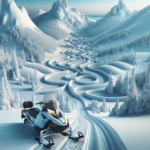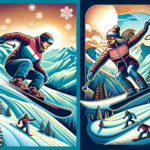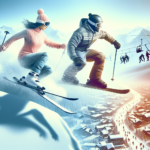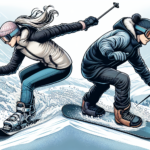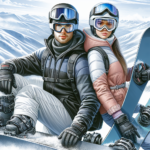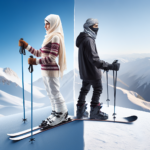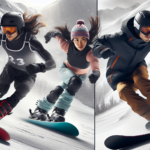If you’re a snowboarding enthusiast eager to conquer the slopes, knowing how to ride a ski lift with your snowboard is a crucial part of the adventure. The article “How To Ride A Ski Lift with a Snowboard?” sheds light on this essential skill every snowboarder needs to master – from stepping onto to the skiing lift, to the right way of placing your snowboard, to your exit strategy once you reach your destination. Packed with tips and tricks, this article ensures you’ll be comfortably ready to scale the mountainside with ease and confidence.
Getting Your Lift Pass
Let’s start at the very beginning. You can’t wait to hit the slopes and carve your path in the fresh snow. But before you do that, you need to get your hands on that essential item: a lift pass.
Understanding Lift Ticket Types
There are different types of lift tickets to accommodate a variety of riders. An adult pass is generally for riders aged between 18 to 64, a child pass is for kids aged 5 to 17, and seniors get their category usually starting from age 65. If you’re planning a multi-day snowboarding extravaganza, you might want to consider getting a weekly or monthly lift pass. There are even season passes for those who like to live off adrenaline throughout the winter.
Buying a Lift Pass
You can buy a lift pass at the resort ticket window. Before you pull out your money or credit card, it’ll be useful to know the price range based on the type of ticket. If you want to avoid queues or if you know exactly when you’ll be visiting, you can opt to buy your pass online from the resort’s website.
Wearing Your Lift Pass Correctly
Once you have your lift pass, it’s important to keep it visible at all times. You can attach it to your jacket using the pass holder, ensuring that the barcode is easily scannable. This helps lift operators to quickly check your pass and keep the queue moving.
Approaching the Lift
Getting on a lift might seem intimidating at first, but with a little knowledge and practice, you’ll get the hang of it.
Identifying the Right Lift
Resorts typically have multiple lifts serving different routes. So, check the resort map and make sure you’re queuing for the right lift that leads you to your desired slope. Pay attention to the signs and follow the instructions by the lift operators.
Unstrapping Your Back Foot
As you approach the lift line, ensure that you’ve unstrapped your back foot from the snowboard. Keep control of your snowboard using your front foot that’s still strapped in and use your free foot for movement and balance.
When your turn comes, move to the gate confidently. Remember, you need to wait for the gate to open before moving forward to board the lift.
Boarding the Ski Lift
Here we go! This is where all the fun begins.
Timing Your Boarding
Watch the chair as it comes around and be ready to sit when it reaches you. Remember, the lift operator is there to help, so if you need them to, they can slow down the lift for you.
Safely Mounting the Lift
As the chair swings around, position yourself to sit down, keeping your board pointing forward. Once you’re seated, lower the safety bar.
Positioning Your Snowboard
Place your unstrapped foot on your board between your bindings. This prevents your board from dangling and hitting other lift users.
Riding the Lift
Sitting on the ski lift and looking at the beautiful snowy landscape is one of the most enjoyable moments for many riders.
Staying Balanced
While you’re on the lift, to keep your balance, avoid leaning too far forward or backward or swinging the chair.
Interacting with Other Riders
Don’t hesitate to strike up a conversation with your fellow riders. Snowboarders and skiers are generally a friendly bunch.
Watching for Your Exit
As you near your exit, prepare to lift the safety bar and make your exit. Use the lift towers as a reference for timing. After the second-to-last tower, get ready for your exit.
Exiting the Lift
Preparing to Dismount
As your exit approaches, shift to the edge of the seat, move your unstrapped foot forward, and prepare to stand.
Timing Your Exit
Wait for the marked line before you stand. Push off gently from the chair with your free foot and try to slide smoothly away from the off-loading area.
Moving Away Safely
After leaving the lift, move out of the way quickly to avoid being hit by the next chairs or other riders coming off the lift. You can strap your back foot back into your snowboard once you’re in a safe spot.
Dealing With Falls
We all fall, and there’s no shame in it. The key is to get up safely and avoid causing accidents.
Getting Up Safely
If you fall while trying to get off the lift, try getting up quickly, relocating your snowboard, and sliding out of the way.
Avoiding Accidents
Make sure you don’t linger or block the way where others are descending or trying to exit the lift. Always be alert and aware of your surroundings.
Dealing with Lift Stop Procedures
In case of a sudden stop, stay calm and wait for the lift to start again. In the event of an emergency, listen and adhere to the instructions issued by the ski patrol or lift operator.
Managing Your Snowboard on the Lift
Other than keeping yourself safe, you are also responsible for the safety of your fellow ski lift riders.
Positioning Your Snowboard Properly
By keeping your unstrapped foot on your snowboard, you prevent it from swinging wildly, which may injure others.
Preventing Your Board from Swinging
As you ride, avoid swinging your board. This will keep both the snowboard and yourself in control while you are on the lift.
Ensuring the Safety of other Riders
Always be mindful of other riders around you. Small things like positioning your snowboard correctly and not swinging it can go a long way towards ensuring everyone’s safety.
Recognizing Lift Safety Signs
Being aware of and following resort’s safety regulations can significantly help reduce accidents and ensure a pleasant experience for all riders.
Understanding Different Lift Safety Sign Colors and Symbols
Signs with green, blue, and black circles or squares indicate the difficulty of the trail they lead to. Green is easier, blue is intermediate, and black is harder. A yellow diamond indicates caution, while a red circle with a line through it alerts to a closed trail.
Obeying Lift Safety Signs
Always respect and follow the directions given by the lift safety signs. They are there to keep you and others safe.
Ensuring Personal Safety On and Off the Lift
Don’t rush or try to push your way through the lines. Also, remember to adjust your clothing and equipment securely before and after your lift ride to avoid any unexpected mishaps.
Riding a Different Types of Lifts
Different types of ski lifts come with their own set of rules and instructions.
Understanding Chair Lifts
Chair lifts are the most common type of lift at ski resorts. They range from a single seat to chairs that can accommodate up to eight riders.
Understanding Gondola Lifts
Gondola lifts have closed cabins that can carry a larger number of people. They typically travel a bit slower, offering a comfortable, enjoyable ride with panoramic views.
Understanding T-bar Lifts
T-bar lifts are a bit trickier. They require you to rest the bar against your thighs and let it propel you up the hill. No sitting down involved.
Practical Tips for First-Time Riders
Overcoming Fear of Heights
If you’re feeling a bit nervous about the height, don’t fret. Focus on the beautiful view ahead and breathe. Remember, you’re securely seated with a safety bar in place.
Taking Lessons
There’s no shame in taking a lesson or two to familiarize yourself with the lift procedure. It’ll boost your confidence and make your time on the slopes enjoyable.
Practicing Safe Lift Riding
Be aware, be considerate, be safe. Remember, all seasoned snowboarders were beginners once, and understanding the lifts is part of the experience.
That wraps up our comprehensive guide on riding a ski lift with a snowboard. Remember, safety comes first, but don’t forget to enjoy the experience. Happy snowboarding!
- What Snowboard Bindings Should I Get? - January 23, 2024
- What Size Screws For Snowboard Bindings? - January 23, 2024
- How To Snowmobile On Water? - January 23, 2024


